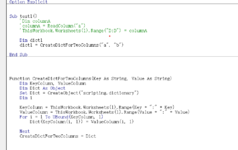-
If you would like to post, please check out the MrExcel Message Board FAQ and register here. If you forgot your password, you can reset your password.
You are using an out of date browser. It may not display this or other websites correctly.
You should upgrade or use an alternative browser.
You should upgrade or use an alternative browser.
Error in VBA(wrong number of arguments or invalid property assignment)
- Thread starter JiangSH
- Start date
-
- Tags
- debug error error vba
Excel Facts
Difference between two dates
Secret function! Use =DATEDIF(A2,B2,"Y")&" years"&=DATEDIF(A2,B2,"YM")&" months"&=DATEDIF(A2,B2,"MD")&" days"
Are you trying to do this?

 stackoverflow.com
stackoverflow.com
What is the easiest way to take two columns of data and convert to dictionary?
I have a worksheet with data in columns A and B. I am looking for a convenient way to take these columns and convert to dictionary where the cell in column A is the key and column B is the value,
Upvote
0
Peter_SSs
MrExcel MVP, Moderator
- Joined
- May 28, 2005
- Messages
- 63,880
- Office Version
- 365
- Platform
- Windows
Welcome to the MrExcel board!
When asking questions about a particular code please post the actual code, not a picture of it. My signature block below has more help on how to do that.
Also, if asking about an error, as well as giving the error message, tell us which line of code caused the error.
When asking questions about a particular code please post the actual code, not a picture of it. My signature block below has more help on how to do that.
Also, if asking about an error, as well as giving the error message, tell us which line of code caused the error.
Upvote
0
A bit troublesome since code is short ? . I'm just guessing your problem here.
This is not way to add data to Dictionary
The Dict(KeyColumn(i, 1)) = ValueColumn(i, 1)
should be
Dict.Add KeyColumn(i, 1), ValueColumn(i, 1)
However, your column has no range limit. When KeyColumn(i, 1) becomes rows of zero or blank, then you will have error.
This is not way to add data to Dictionary
The Dict(KeyColumn(i, 1)) = ValueColumn(i, 1)
should be
Dict.Add KeyColumn(i, 1), ValueColumn(i, 1)
However, your column has no range limit. When KeyColumn(i, 1) becomes rows of zero or blank, then you will have error.
Upvote
0
Peter_SSs
MrExcel MVP, Moderator
- Joined
- May 28, 2005
- Messages
- 63,880
- Office Version
- 365
- Platform
- Windows
Dict(SomeKeyValue) = SomeItemValueThis is not way to add data to Dictionary
The Dict(KeyColumn(i, 1)) = ValueColumn(i, 1)
.. is a perfectly valid way to add an entry to a Dictionary.
One thing that I noticed about the code is that "Key" and "Value" are used as variable arguments for the function and it is a very bad idea to use words as variables that vba already has special meanings for.
There could also be an issue with the type of double quote marks used.
Upvote
0
Yes, you are right. Value can be added that way too. My bad. Here is what I convertedDict(SomeKeyValue) = SomeItemValue
.. is a perfectly valid way to add an entry to a Dictionary.
One thing that I noticed about the code is that "Key" and "Value" are used as variable arguments for the function and it is a very bad idea to use words as variables that vba already has special meanings for.
There could also be an issue with the type of double quote marks used.
VBA Code:
Option Explicit
Sub testl()
'Dim columnA
'coluinnA = ReadColumn("a")
'ThisWorkbook. Worksheets (1). Range ("D:D") = coluinnA
Dim dictl
dictl = CreateDictForTwoColumns("a", "b")
End Sub
Function CreateDictForTwoColumns(Key As String, Value As String)
Dim KeyColumn, ValueColumn
Dim Dict As Object
Set Dict = CreateObject("scripting.dictionary")
Dim i
KeyColumn = ThisWorkbook.Worksheets(1).Range(Key + ":" + Key)
ValueColumn = ThisWorkbook.Worksheets(1).Range(Value + ":" + Value)
For i = 1 To UBound(KeyColumn, 1)
Dict(KeyColumn(i, 1)) = ValueColumn(i, 1)
Next
CreateDictForTwoColumns = Dict
End Function
Upvote
0
Peter_SSs
MrExcel MVP, Moderator
- Joined
- May 28, 2005
- Messages
- 63,880
- Office Version
- 365
- Platform
- Windows
It is not entirely clear what the OP is wanting to achieve, but this is my estimate.
VBA Code:
Sub test1()
Dim dictl As Variant
dictl = CreateDictForTwoColumns("a", "b")
End Sub
Function CreateDictForTwoColumns(sKey As String, sValue As String)
Dim KeyColumn As Variant, ValueColumn As Variant
Dim Dict As Object
Dim i As Long
Set Dict = CreateObject("scripting.dictionary")
KeyColumn = ThisWorkbook.Worksheets(1).Range(sKey + ":" + sKey)
ValueColumn = ThisWorkbook.Worksheets(1).Range(sValue + ":" + sValue)
For i = 1 To UBound(KeyColumn, 1)
Dict(KeyColumn(i, 1)) = ValueColumn(i, 1)
Next
CreateDictForTwoColumns = Array(Dict.Keys, Dict.Items)
End Function
Upvote
0
you estimate is right! That is excactly what i want ! thinks!!It is not entirely clear what the OP is wanting to achieve, but this is my estimate.
VBA Code:Sub test1() Dim dictl As Variant dictl = CreateDictForTwoColumns("a", "b") End Sub Function CreateDictForTwoColumns(sKey As String, sValue As String) Dim KeyColumn As Variant, ValueColumn As Variant Dim Dict As Object Dim i As Long Set Dict = CreateObject("scripting.dictionary") KeyColumn = ThisWorkbook.Worksheets(1).Range(sKey + ":" + sKey) ValueColumn = ThisWorkbook.Worksheets(1).Range(sValue + ":" + sValue) For i = 1 To UBound(KeyColumn, 1) Dict(KeyColumn(i, 1)) = ValueColumn(i, 1) Next CreateDictForTwoColumns = Array(Dict.Keys, Dict.Items) End Function
Upvote
0
ok I will keep this in mind! really appreciate your instructions!Welcome to the MrExcel board!
When asking questions about a particular code please post the actual code, not a picture of it. My signature block below has more help on how to do that.
Also, if asking about an error, as well as giving the error message, tell us which line of code caused the error.
Upvote
0
Similar threads
- Replies
- 3
- Views
- 77
- Replies
- 2
- Views
- 79
- Replies
- 9
- Views
- 353
- Question
- Replies
- 11
- Views
- 1K
- Locked
- Question
- Replies
- 1
- Views
- 178






